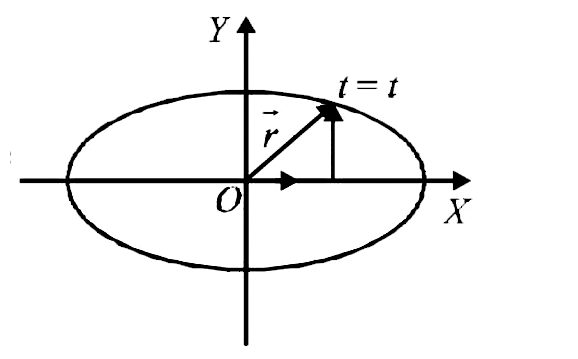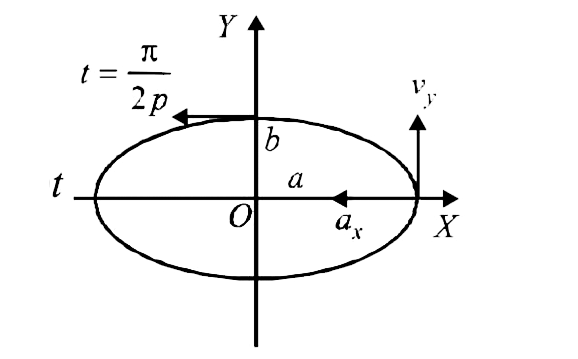The coordinate of a particle moving in a plane are given by x(t)=acos(pt)andy(t)=bsin(pt) where a,b(<a) and P are positive constants of appropriate dimensions . Then
the path of the particle is an ellipse
the velocity and acceleration of the particle are normal to each other at t=π/(2p)
the accelaration of the particle is always directed towards a focus
the distance travelled by the particle in time interval t=0→t=π/(2p) is a
The correct Answer is:A, B, C
x=acospt⇒cos(pt)=x/a …(1)
y=bsinpt⇒sin(pt)=yb …(2)
Squaring and adding (1)and(2), we get ,
x2a2+y2b2=1
∴ The path of the particle is an ellipse.
From the given equations we can find ,
dxdt=vx=−apsinpt,dxdt2=ax=−ap2cospt
dydt=vy=pbcospt
and d2ydt2=ay=−bp2sinpt
At time t=π2p , or pt = (pi)/(2)<br>a_(x)andv_(y)becomeszero(∵cos (pi)/(2) = 0).Onlyv_(x)anda_(y)are≤ft,<br>orwecansaytˆvelocityisalong¬ative x-axis andae≤rationalong¬ativey - axis.Hence,att = (pi)/( 2p),velocityandae≤rationofthepartic≤are∥a∥l→eachother.<br>At t = t,positionofthepartic≤vec r(t) = xhati + yhatj = xhati + yhatj = a cos p thati + b sin pthatjandae≤rationofthepartic≤is<br> a(t) = a_(x) hati + a_(y) hat j = - p^(2) [ a cos pt hat i + b sin pt hatj]<br> = - p^(2)[ xhati + yhatj ] = -p^(2) vec r(t)Therefore,ae≤rationofthepartic≤isalwaysdirected→wardsorig∈.At t= 0 ,partic≤isat(a, 0)andatt = (pi)/(2p),partic≤isat( 0, b).Therefore,thedistancecoverediso≠fourthoftheellipticalpathand¬a .


Topper's Solved these Questions
Similar Questions
Knowledge Check
- Question 1 - Select One or More
The coordinates of a particle moving in a plane are given by x(t)=acos(pt)andy(t)=bsin(pt) where a,b(<a)andp are positive constants of appropriate dimensions. Then
Athe path of the particle is an ellipse.Bthe velocity and acceleration of the particle are normal to each other at t=π/(2p).Cthe acceleration of the particle is always directed toward a focus.Dthe distance traveled by the particle in time interval t = 0 to t=π/(2p) is a. - Question 2 - Select One
The coordinates of a moving particle at any time t are given by x = ct and y = bt. The speed of the particle at time t is given by
A2t(c-b)B√(c2+b2)C2t√(c2+b2)D2t√(c2+b2) - Question 3 - Select One
The coordinates of a moving particle at any time t are given by x=ct and y=bt2. The speed of the particle is given by
A2t√b2−c2B√4b2t2+c2C2t(b+c)D2t(b−c)
The coordinates of a particle moving in XY-plane very with time as x=4t2,y=2t. The locus of the particle is
View SolutionThe coordinates of a particle moving in XY-plane vary with time as x=4t2,y=2t. The locus of the particle is a : -
View SolutionThe coordinates of a moving particle at any time t are given by x=αt3 and y=βt3. The speed of the particle at time t is given by
View SolutionThe coordinates of a moving particle at time t are given by x=ct2 and y=bt2. The speed of the particle is given by :-
View SolutionThe equations of motion of a particle P(x,y) on a plane are given by x=4+r.cost,y=6+r.sint, where t is time and r is constant . Its velocity at time t is
View Solution

